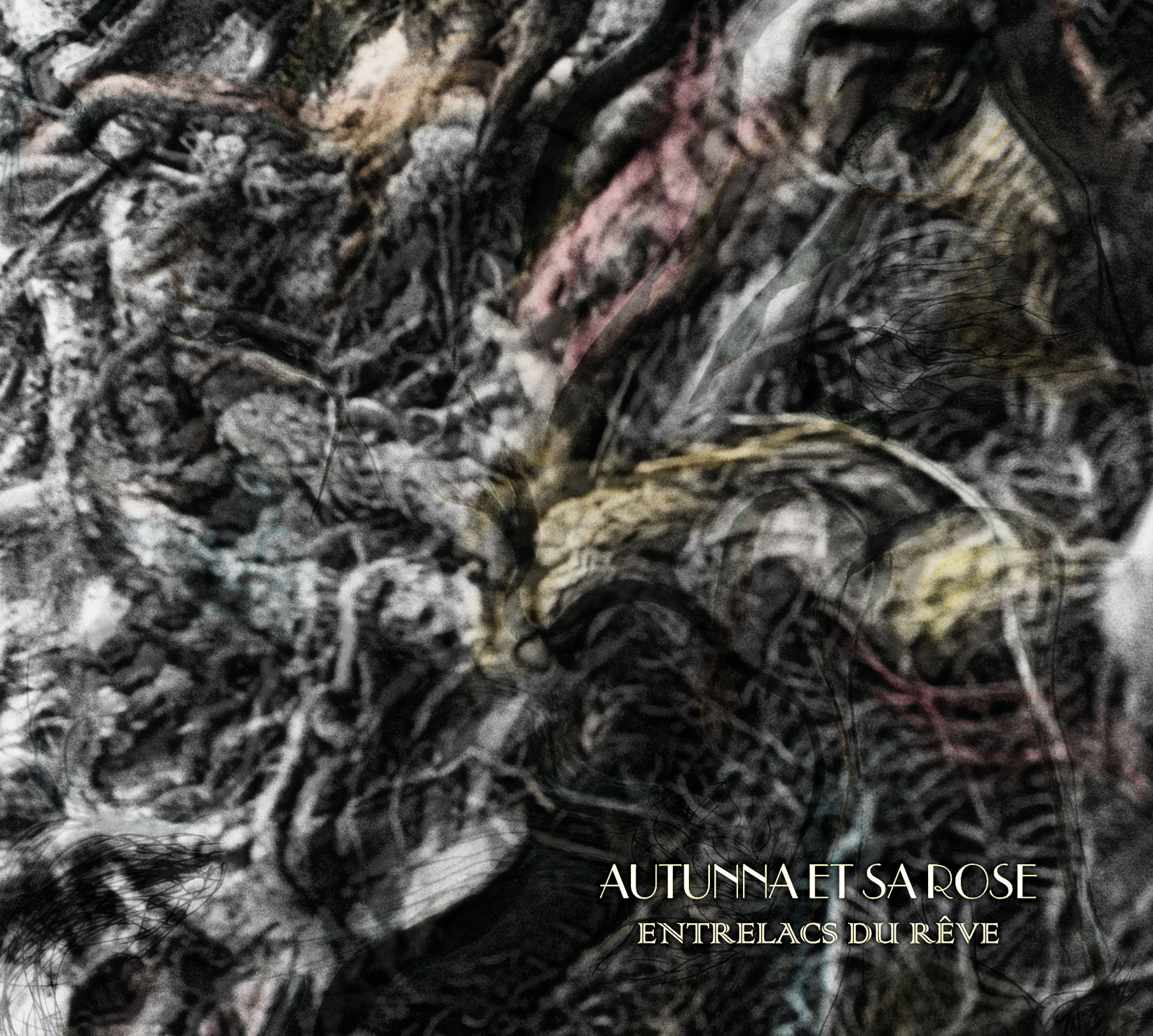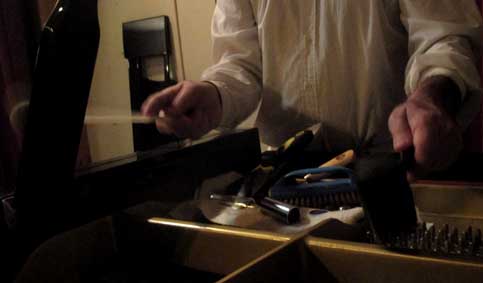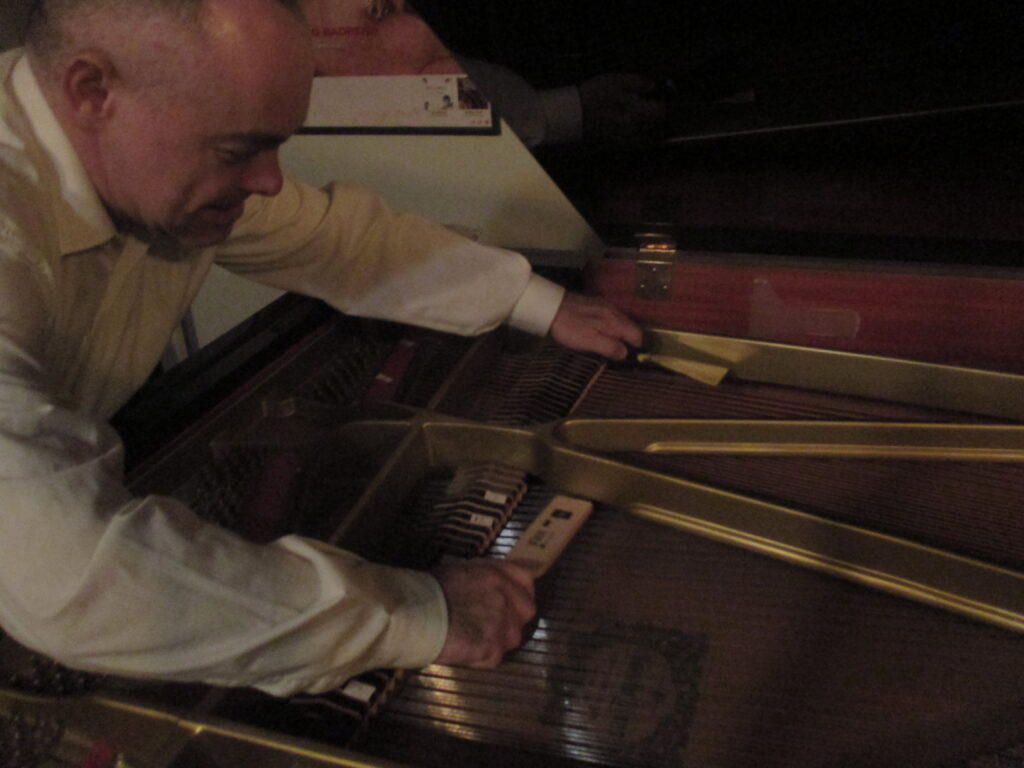
| 1. Dromomania 11-16 for cello and piano 2. Marsch des dumpfen Herumwanderers for mezzosoprano, cello, percussion and electronics 3. Flutter of Asbestos and Quartz Wings improvisation for piano, recorded piano and electronics 4. S’engouffrer dans ces nœuds… for soprano and mezzosoprano 5. Ossescacco for cello and piano 6. Tanz der toten Schachfiguren for soprano, cello, snare, percussive samples and electronics 7. Sharp Glitches and White Noise (on the Screen) improvisation for piano, recorded piano and electronics 8. Au-delà… de la borne X for soprano and mezzosoprano |
 The structure of the Dreamlinks
The structure of the Dreamlinks project has been deliberately split into two separate sections, respecting the already tested many-sided combination of poetry, graphics and music. Thus, the result is a unitary work, the two parts of which reflect in one another in relation to its subject: in fact, some months before the issue of this CD, a book with a homonymous title has been published, though in Italian (Intrecci del sogno, available at www.amazon.it/Intrecci-del-sogno-Saverio-Tesolato/dp/8892330225, also in e-book format).
As a matter of fact, it was my oneiric activity during summer 2014 that led me to the realisation of this project: in particular, two were the dreams my memory could perfectly preserve soon after the awakening, so that I initially sketched out, as roughly as possible, the most relevant oneiric images, such as my mind was instantly able to reconstruct them. Surprisingly, the final result was a real narration of these dreams in form of two tales, due to a sort of a detailed backward analysis – sometimes very hard to realize, when not even agonizing – of the images my brain had jealously decided to preserve. Since then I find it absolutely natural to create several musical counterparts to each oneiric representation, in order to link text and music together: as a matter of fact, even though the first compositional structure to be chosen for both dreams was the cello-piano duo (often constructed as a sort of a ”match”, a game played by two sides), it was clear that new forms were designed to follow the first one, with the aim of ensuring some varied visions and multi-sided interpretations, emerged more and more strongly during the writing of the two tales. So from each dream four tracks have been generated, each one having a different form of composition: to be more precise, the two original cello-piano duos have been the basis to build the further three forms, as if they were “sons” of a “father” from whom they carefully retained an unstable leitmotiv; afterwards, two compositions for female


lyrical vocals, cello, percussion and electronics were created; then, I could not yield to temptation of the piano improvisation, which fascinated me so much that I decided to boost the improvisational practice – already developed in the recent past – by working with alacrity on string piano techniques (enriched with a personal touch, by using several tools to play with) and electronic sound processing, in order to assemble a pre-recorded track, finally used to play a synchronized live keyboard piano part; lastly, I directed my efforts towards the composition of two duos a cappella (for soprano and mezzosoprano), able to maintain a structural continuity with the previous tracks, and even deepening the conceptualization of the whole work.
Besides, it is the language deliberately given to the title of each piece of music that can make you detect the kind of its composition: as a matter of fact, the instrumental duos have Italian titles, since they are directly related to the images of the dreams and to their narrations (Dromomania 11-16 and Ossescacco, both made by a single word, able to condense the general sense of the entire dream); the vocal-instrumental pieces with percussion and electronic accompaniment have German titles (Marsch des dumpfen Herumwanderers [March of the Gloomy Wanderer] and Tanz der toten Schachfiguren [Dance of the Dead Chess Pieces]: the choice of their language is surely justified by the dark nature of the tracks…); the two (double) improvisations have English titles, Flutter of Asbestos and Quartz Wings and Sharp Glitches and White Noise (on the Screen), referring to two peculiar oneiric images that you can find along the narrations; lastly, the solo vocal duos have French titles, S’engouffrer dans ces nœuds… [Sinking into Those Knots…] and Au-delà… de la borne X [Beyond… the X-Border], hence closing the loop with the title of the work.
As regards the title Entrelacs du rêve, the choice of French is justified not only by references contained in some past compositions, but even by the meaning of the French word entrelacs: in the mathematics vocabulary concerning Knot theory, where the definition of link is in fact a generalization of the one of knot (precisely, it is a collection of knots which do not intersect, but which may be linked together). Besides, since ancient times, many presentations of various links have often been depicted, more recurrently in low reliefs and mosaics, as, for instance, the famous Solomon’s knot (or link), that often occurs in ancient Roman mosaics and in several Early Christian cathedrals: in fact, in a religious connotation, the knot represents immortality and eternity, and the union between the Human being and the dimension of God, but a wider range of symbolic interpretations are also known, especially connected to esotericism. As a matter of fact, the basic principles of the link theory have been used in order to define the fundamental strategies for the compositional technique of S’engouffrer dans ces nœuds…: here the two voices repeatedly interlace, each one singing at a pitch that must be simultaneously higher or lower than the other voice’s one, but often changing it and their reciprocal interval relationships, in a sort of “musical translation” of what the so-called primary links represent in a visual form. As far as the second vocal duo, Au-delà… de la borne X, is concerned, the score requires that the vocalists move at specified times, in directions crossing each other: this is the reason why this track has been recorded by employing a special microphone positioning system, in order to catch “moving” audio signals coming from the four corners of a quadrangular room. The inspiration for the composition of this piece came from a canvas by Vinicio Berti, an abstract painter from Tuscany, entitled (of course…) Intrecci.
In addition, some images have been created so as to naturally complete the work – on the supposition that it can really have this kind of achievement… – and used to accompany the text of the tales, in order to try to evoke the most significant images in the dreams.
The topic of dreams (and of their reality) had been discussed since the beginning of the 20th century thanks to the works of Sigmund Freud on psychoanalysis, which was mainly focused on the elaboration of scientific methods of interpretation of dreams; later, Surrealists have designated dream as a fundamental law of the spirit, i.e. a place where the unconscious discovered by Freud can lead to uncontrolled manifestations, and where you can have a proof of the irresistible truth it embodies and realize that it is the privileged channel of communication between life on Earth and the afterlife. This is one of the innumerable reasons why I felt obliged to start composing music for (those) dreams: in fact, so many times in the past there has been music inside them, both as background music, and in other forms, for instance, as a result of playing instruments in dreams. After waking up from the dreams I have told about here, no sonic memories have been saved, no kind of sounds: but this does not imply that no music was really in them. As a matter of fact, it is just thanks to the above-mentioned backward analysis that I could write several pieces of music for each dream, whose compositions have been surely influenced by sense and sensitivity. In any case, it has also been an effective (and powerful) means to interpret these visions, to try to understand the past, to give future a deep meaning the tales, in order to try to evoke the most significant images in the dreams.
Several musicians have participated in the recordings of Entrelacs du rêve: it is surely worth remembering the essential contribution of the soprano leggiero Sonia Visentin (well-known since many years as a fundamental interpreter of several roles in opuses from Claudio Ambrosini and Adriano Guarnieri) and of the mezzosoprano Matilde Secchi, once more together, in order to interlace their sweet vocalises and trills, so as the listener can become entangled into the gloomiest oneiric substance.
Finally, in July 2018 a paper has been also prepared where the compositional techniques of this piece are explained in detail. It is entitled Dreamlinks: Link Theory Meets Music Composition. An Introduction to Compositional Methods Related to Primary Links and it was presented at the 21st Bridges Conference (in Stockholm, Sweden), the world’s largest conference on mathematical connections in art, music, architecture, education and culture. The above-mentioned article was published in the Bridges 2018 Proceedings (watch the presentation VIDEO).
| PERSONNEL Sonia Visentin soprano |

